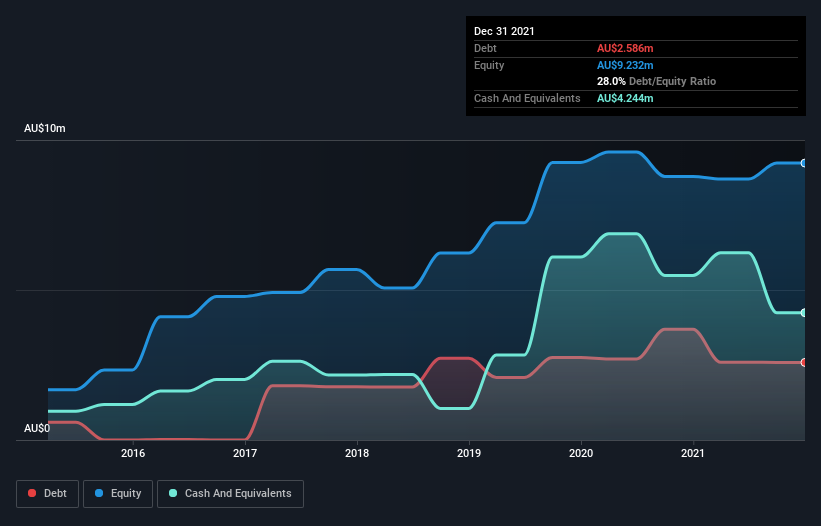We Think Rectifier Technologies (ASX:RFT) Can Stay On Top Of Its Debt
Some say volatility, rather than debt, is the best way to think about risk as an investor, but Warren Buffett famously said that 'Volatility is far from synonymous with risk.' It's only natural to consider a company's balance sheet when you examine how risky it is, since debt is often involved when a business collapses. We note that Rectifier Technologies Limited (ASX:RFT) does have debt on its balance sheet. But the real question is whether this debt is making the company risky.
When Is Debt A Problem?
Debt and other liabilities become risky for a business when it cannot easily fulfill those obligations, either with free cash flow or by raising capital at an attractive price. In the worst case scenario, a company can go bankrupt if it cannot pay its creditors. However, a more common (but still painful) scenario is that it has to raise new equity capital at a low price, thus permanently diluting shareholders. Having said that, the most common situation is where a company manages its debt reasonably well - and to its own advantage. When we examine debt levels, we first consider both cash and debt levels, together.
Check out our latest analysis for Rectifier Technologies
How Much Debt Does Rectifier Technologies Carry?
You can click the graphic below for the historical numbers, but it shows that Rectifier Technologies had AU$2.59m of debt in December 2021, down from AU$3.69m, one year before. But on the other hand it also has AU$4.24m in cash, leading to a AU$1.66m net cash position.
How Healthy Is Rectifier Technologies' Balance Sheet?
We can see from the most recent balance sheet that Rectifier Technologies had liabilities of AU$4.14m falling due within a year, and liabilities of AU$3.33m due beyond that. On the other hand, it had cash of AU$4.24m and AU$3.98m worth of receivables due within a year. So it actually has AU$753.1k more liquid assets than total liabilities.
This state of affairs indicates that Rectifier Technologies' balance sheet looks quite solid, as its total liabilities are just about equal to its liquid assets. So it's very unlikely that the AU$81.2m company is short on cash, but still worth keeping an eye on the balance sheet. Succinctly put, Rectifier Technologies boasts net cash, so it's fair to say it does not have a heavy debt load!
Importantly, Rectifier Technologies's EBIT fell a jaw-dropping 71% in the last twelve months. If that decline continues then paying off debt will be harder than selling foie gras at a vegan convention. There's no doubt that we learn most about debt from the balance sheet. But you can't view debt in total isolation; since Rectifier Technologies will need earnings to service that debt. So when considering debt, it's definitely worth looking at the earnings trend. Click here for an interactive snapshot.
Finally, while the tax-man may adore accounting profits, lenders only accept cold hard cash. Rectifier Technologies may have net cash on the balance sheet, but it is still interesting to look at how well the business converts its earnings before interest and tax (EBIT) to free cash flow, because that will influence both its need for, and its capacity to manage debt. Over the last three years, Rectifier Technologies recorded free cash flow worth a fulsome 90% of its EBIT, which is stronger than we'd usually expect. That positions it well to pay down debt if desirable to do so.
Summing up
While it is always sensible to investigate a company's debt, in this case Rectifier Technologies has AU$1.66m in net cash and a decent-looking balance sheet. The cherry on top was that in converted 90% of that EBIT to free cash flow, bringing in -AU$896k. So we don't have any problem with Rectifier Technologies's use of debt. The balance sheet is clearly the area to focus on when you are analysing debt. But ultimately, every company can contain risks that exist outside of the balance sheet. Case in point: We've spotted 4 warning signs for Rectifier Technologies you should be aware of.
At the end of the day, it's often better to focus on companies that are free from net debt. You can access our special list of such companies (all with a track record of profit growth). It's free.
Have feedback on this article? Concerned about the content? Get in touch with us directly. Alternatively, email editorial-team (at) simplywallst.com.
This article by Simply Wall St is general in nature. We provide commentary based on historical data and analyst forecasts only using an unbiased methodology and our articles are not intended to be financial advice. It does not constitute a recommendation to buy or sell any stock, and does not take account of your objectives, or your financial situation. We aim to bring you long-term focused analysis driven by fundamental data. Note that our analysis may not factor in the latest price-sensitive company announcements or qualitative material. Simply Wall St has no position in any stocks mentioned.

 Yahoo Finance
Yahoo Finance 
